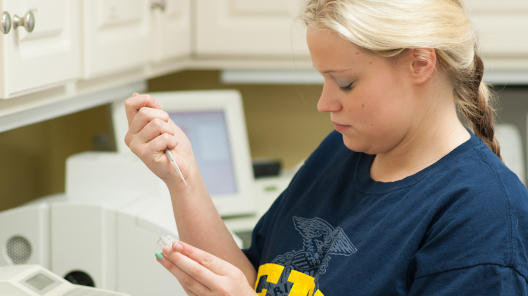Patólogo veterinario
Los patólogos veterinarios son médicos veterinarios que diagnostican enfermedades mediante el examen de tejidos y fluidos corporales de los animales. Los patólogos veterinarios anatómicos diagnostican enfermedades basándose en el examen de órganos, tejidos y cuerpos. Los patólogos veterinarios clínicos basan su diagnóstico en el análisis de orina, sangre u otros fluidos corporales.
¿Qué responsabilidades tendré?
- Completar exámenes post-mortem en animales pequeños y grandes para determinar la causa de muerte del animal y diagnosticar enfermedades.
- Supervisar la preparación de tejidos para las pruebas
- Análisis completos de muestras de sangre y tejidos para diagnosticar diversas enfermedades y afecciones
- Discutir los resultados de los estudios con los clientes y sugerir opciones de tratamiento a los veterinarios.
- Analizar los resultados de las pruebas y estudios de laboratorio
- Trabajar conjuntamente con asociados y clientes en el desarrollo del diseño de los estudios.
- Practicar y promover procedimientos de laboratorio éticos
- Realizar estudios de conformidad con la FDA y otras agencias reguladoras nacionales e internacionales.
- Interactuar con el personal de laboratorio y asesorarle sobre las técnicas adecuadas de manipulación y procesamiento de muestras.
- Contribuir al desarrollo de medicamentos y productos zoosanitarios
- Realizar estudios de investigación y, a continuación, resumir y comunicar las tendencias para los informes.
- Mantener un conocimiento actualizado de las normas del sector y de los equipos presentes en un hospital veterinario y en un laboratorio.
- Asesorar a los organismos gubernamentales sobre la propagación y progresión de las enfermedades animales.
- Cumplir los protocolos de seguridad estándar y mantener un entorno limpio y estéril.
- Mantener la competencia y desarrollar las habilidades de diagnóstico clínico
Cursos de bachillerato recomendados:
- educación agrícola
- zootecnia
- veterinaria
- Inglés
- centrarse en matemáticas y ciencias de nivel superior, como estadística, álgebra, genética, biología y química
Formación requerida:
Además de obtener un doctorado en medicina veterinaria, los patólogos veterinarios deben completar una amplia residencia en patología anatómica o clínica en un hospital universitario veterinario. Para obtener la certificación de la junta, las personas deben completar un mínimo de tres años de formación clínica y aprobar los exámenes de certificación de la junta.




